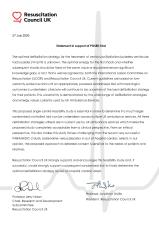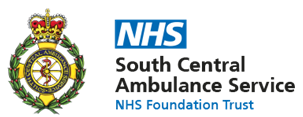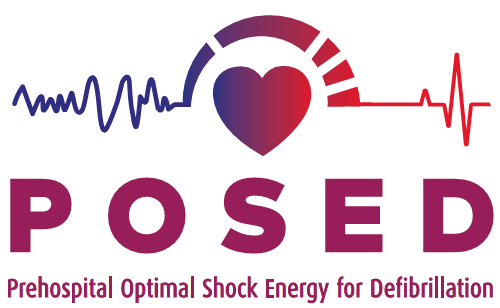Information for health professionals
Background:
Cardiac arrest, the cessation of the pumping action of the heart, is one of the primary causes of premature death across the world.[1] A lack of mechanical activity of the heart may be accompanied by a number of different electrical states, broadly divided into ‘shockable’ and ‘non-shockable’ rhythms. The shockable rhythms, ventricular fibrillation and (pulseless) ventricular tachycardia, may be characterised by the rapid and chaotic passage of electrical signals through the heart resulting in a lack of co-ordinated pumping action. Cessation of this chaotic activity is an essential precursor to restoration of a perfusing rhythm.[2]
In 2014, approximately 30,000 resuscitation attempts were made by UK emergency medical services (EMS). Of these, 6,000 (20%) were in an initially shockable rhythm and, of these, 20.9% survived to hospital discharge.[3]
There is currently no clear consensus on optimal shock energies; European Resuscitation Council (ERC) guidelines advising both to treat with an initial energy of at least 150J for biphasic waveforms, escalating after a failed shock if the defibrillator is capable, and to base shock energy on manufacturers’ guidance.[4] The International Liaison Committee on Resuscitation (ILCOR) has identified defibrillation energy levels as a priority area for research.[5]
If the shock energy is right first time, the resuscitation duration is shortened, and circulation restored more quickly. The chance of surviving with good neurological outcome at one month is significantly higher in those achieving ROSC within 5 minutes compared to those who achieve ROSC after more than 31 minutes (AOR 0.04; 95% CI 0.03-0.05).[6] It is important to shorten the resuscitation duration by delivering the optimal shock energy on first and subsequent shocks.
The evidence base for first shock energy is weak as is that for subsequent shock energies; much of the evidence is based on old resuscitation regimes and uses a variety of different endpoints making meaningful comparison difficult.[7] There is a clear need to ascertain (1) optimal first shock energy and (2) subsequent shock strategy, to improve outcomes following cardiac arrest.
- Nolan, J.P., G.D. Perkins, and J. Soar, Improving survival after out-of-hospital cardiac arrest. British Medical Journal, 2015.
- Adgey, A., M. Spence, and S. Walsh, Theory and practice of defibrillation: (2) Defibrillation for ventricular fibrillation. Heart, 2005. 91: p. 118-125.
- Hawkes, C., Booth, S., Ji, C., Brace-McDonnell, S.J., Whittington, A., Mapstone, J., Cookes, M.W., Deakin, C.D., Gale, C.P., Fothergill, R., Nolan, J.P., Rees, N., Soar, J., Siriwardena, A.N., Brown, T.P., Perkins, G.D. on behalf of OHCAO collaborators, Epidemiology and outcomes from out-of-hospital cardiac arrests in England. Resuscitation, 2017. 110: p. 133-140.
- Soar, J., et al., European Resuscitation Council Guidelines for Resuscitation 2015: Section 3. Adult advanced life support. Resuscitation, 2015. 95: p. 100-147.
- Soar, J., et al., Part 4: Advanced life support: 2015 International Consensus on Cardiopulmonary Resuscitation and Emergency Cardiovascular Care Science with Treatment Recommendations. Resuscitation, 2015. 95: p. e71-e120.
- Matsuyama, T., Kitamura, T., Kiyohara, K., Nishiyama, C., Nisiuchi, T., Hayashi, Y., Kawamura, T., Ohta, B., Iwami, T., Impact of cardiopulmonary resuscitation duration on neurologically favourable outcome after out-of-hopstial cardiac arrest: A population-based study in Japan. Resuscitation, 2017. 113: p. 1-7.
- Morrison, L.J., et al., Single-shock defibrillation success in adult cardiac arrest: a systematic review. Resuscitation, 2013. 84: p. 1480-1486.
Trial Summary:
|
Study Title
|
A feasibility study of Prehospital Optimal Shock Energy for Defibrillation |
|
|
Short title
|
POSED |
|
|
Study Design
|
Single site three-armed parallel-group feasibility randomised controlled trial
|
|
|
Study Participants
|
Adult patients suffering out-of-hospital cardiac arrest attended by a crew from the participating ambulance service in whom resuscitation is attempted and a shock indicated. |
|
|
Planned sample size
|
90 (30 in each arm) |
|
|
Treatment Duration
|
Duration of cardiac arrest (up to approximately 60-minutes) |
|
|
Follow-up Duration
|
To hospital discharge or 30-days (whichever is later) |
|
|
Planned Study Period |
From Sep 2020 to Nov 2022 |
|
|
|
Objectives |
Outcome Measures |
|
Primary
|
Establish whether it is feasible to conduct a large scale definitive trial by establishing the number of eligible patients and the number recruited. |
Eligibility screening logs based on Ambulance Service call data and clinical records. |
|
Secondary |
1. To measure the rate of adherence to the allocated treatment. 2. Identify the best outcome measures in terms of ease and reliability of recording by reviewing data completeness |
Rate of compliance with treatment allocation
Rate of shock data capture on clinical records; Rate of Rankin Focussed Assessment (RFA) completion |
|
Sub-studies |
Objectives |
Outcome Measures |
|
Qualitative
|
Exploration of views and experiences of paramedics regarding recruitment, treatment adherence and data completeness |
Analysis of focus groups data |
Enquiries:
Study Co-ordinator: Jeskaran Rai
Email: POSED@warwick.ac.uk
Address: POSED study
Warwick Clinical Trials Unit
Warwick Medical School
University of Warwick
Gibbet Hill Road
Coventry
CV4 7AL
Resuscitation Council UK - Statement in support of POSED

View statement by clicking here.Link opens in a new window

Click here to go to the South Central Ambulance Service - Research pageLink opens in a new window

